
Check out the results we were able to achieve while having fun and staying on budget.
Here is A quick opening comment and disclaimer. There are many thoughts and ways to go about corpsing. This just happened to be one way that we though resulted in a very nice effect with a low budget and not too much time. This process is a culmination of techniques published on the web and experimentation.
Please note: I have found that enamel spray paint and wood stain used together stay very tacky for extended periods of time. Thick application of carpet latex takes a long time to dry. Do not try this project without allowing a couple of weeks to dry.
Here we go!
Project Checklist
- One Bucky: A bucky is the 4th quality skeleton available through the Anatomical Chart Company. .
- Latex Carpet adhesive: If price is not a problem go with latex instead of Latex Carpet adhesive. Latex Carpet Adhesive has a very, very long dry time. A corpse done three months ago is still tacky to the touch in spots.
- Several pairs of xl pantyhose: These can be in various darker skin tones ( not black).
- Jute: In our town we call erosion control fabric Jute. Some call it dorp. Some call it haunting fabric.
- Flat Black spray paint
- Shellac
- Dark Wood stain
- An old wig
- A pair of gloves worthy of being ruined
- Scissors
- A sturdy place to hang a bucky with a paint tarp under it.
- Lacquer thinner.
- A few 3-2 inch wide Disposable brushes.
This project can be done in 3-8 hours of labor and on a budget of 40$ for 3 corpses.
Step 0. Read up!
Read this information before trying to experiment on your own bucky. There are a couple of key moments that will affect the look of your corpse. There are also considerable dry times. Do not attempt this project one or two weeks before Halloween. Do not attempt to do this project without proper ventilation. Don’t even think about exposing any of this project to heat, flame or torches.
Step 1. Assemble your bucky!
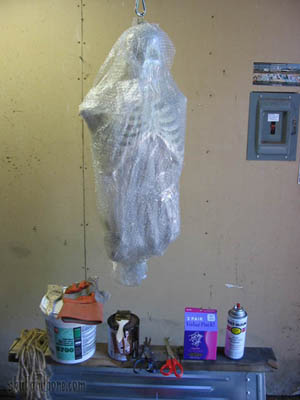
Buckies come packed in nice bubble wrap. Often legs and arms need to be bolted on. I have had one bucky require drilling for the leg bolts.
Buckies can be found all over the web. It is pretty well known that buckies originate from the Anatomical Chart Company. Bucky prices range from less than $90.00 to $150.00. It is worth the research to find a reliable and economical source for the purchase of your bucky.
If you don’t have money, an option to the pricey bucky is the blucky. The name of the blucky often causes some confusion when people don’t realize there is and ‘L’ in the word blucky. Bluckies are blow molded cheap skeletons available at discount stores. I have found them at BigLots for $7.99 each.
Step 2. Hang your bucky!
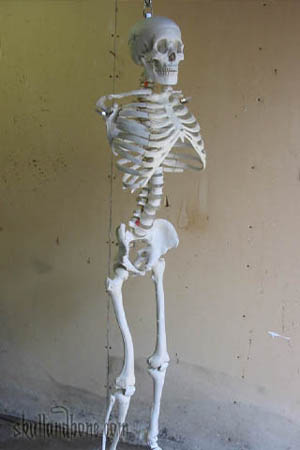
Find a nice sturdy place to hang your bucky for a couple of weeks. Good ventilation is a must. The bucky will smell and will be tacky for several weeks after corpsing. This is not a project to do day or a week before Halloween. Dry times can be extreme when using large amounts of carpet latex.
Step 3. Skin your corpse!

Please note: The strange protuberance was unintentional, the pelvis bolt came loose and had to be tightened.
The clerk always looks at me funny when I go to the dime store to buy a pile of the largest pantyhose possible. Have some fun with the clerk and ask them if you can take them back if they do not fit.
I prefer to skin the torso with two ‘non-control top XXL pantyhose. Pull them up the corpse, all the way to the neck.
Pull the two knee-high pantyhose sox down over the skull so the sox end around the neck. Use the neck as a point to hide the waistbands of all your nylons.
Pull two knee-high sox over each arm and attach the arms to the corpse. All those little snags are not a problem. Just take your time. You will have to punch a few holes for bolts.
Step 4. Distress your skin!

Use some sharp scissors to score your nylon layer of skin. Fill the skin with as many holes and wear as desired. Don’t be afraid to move and stretch your nylons to get the desired look.

Take care when cutting the eye nose and mouth holes. These are the largest source of character for your corpse. Chose your cuts wisely to get a desirable facial expression. Don’t be afraid to put new nylons over the head if your eye holes look awkward.

Decide how much skin you want to be on your corpse before cutting. We personally like to see the bones of the corpse. It helps to make the corpse more visible in low light.
If you want that ‘peeled back skin exposing white bone’ look, save areas without holes to peel back later.
If you want that ‘rotted skin absorbing into bone, go to town with the holes.

I found cutting open the chest cavity gave me a pretty cool look. My intentions will be to light this cavity so light can be seen between the ribs.
Cut away the skin from the fingers and toes.
Where large holes are desired, pull on the skin and cut away bits with the scissors.
Where you desire worm holes in the skin, take the sharp edge of some scissors and drag along the surface of the skin back and forth. Eventually, this will create small pin holes that graduate to larger holes. A utility knife did not work as well as scissors to create wear and tear.
Your corpse’s skin should be shaping up by now.
Step 5. Glue your skin down!
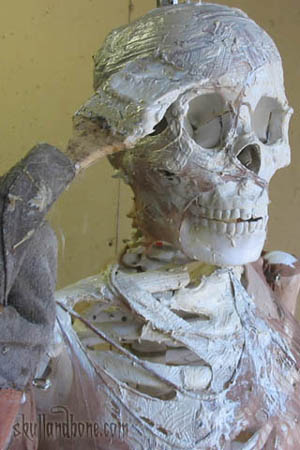
Glove up and go to town with the latex.
Carpet latex is extremely sticky, so make sure to have a tarp down and check your shoes before messing up your wife’s/mom’s carpeting. Apply latex over the nylon skin of your corpse liberally with a brush. Even scooping latex with gloved hands and patting the latex into the skin of the corpse works well.
Take time to notice the effects of the latex on the skin of your corpse. If a certain type of rotting catches your eye, try to apply that to the rest of the corpse.
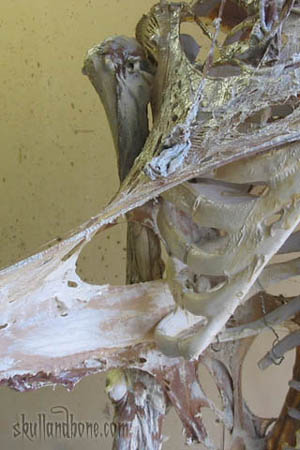
Don’t be afraid to yank and stretch the skin of your corpse. This is the time to experiment with how much skin you want your corpse to have. For a peel-away skin look, leave larger areas of extra skin to peel back later.
As pointed out before we desire an extremely rotted look. At this stage, I take my time stretching and tugging on areas to find the best balance between hanging strands and skin patches.
Keep in mind the thicker your blobs of latex the longer the dry time.
Step 6. Add your strands and bits!
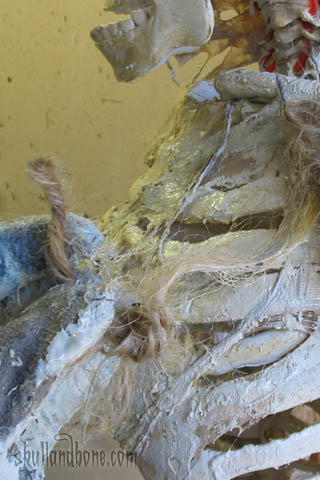
When the corpse skin is satisfactory it is time to think about adding those touches that give the corpse visual depth and character.
Notice how we try to have layer upon layer with the surface of our corpse. Grab yourself some long strands of jute and begin rubbing them into the still-wet skin of your corpse. Take a few blobs of adhesive and brush the jute into the skin. I try to emulate tree roots or dried-up innards.
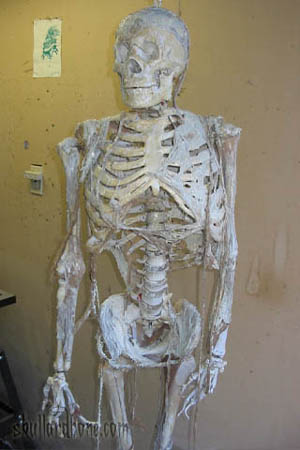
Take your time experimenting with how you drape your strands. Loops, long strands, short strands, and frayed edges are all cool details on your corpse.
Anything that is not bolted down, can be a candidate for becoming a strand or a bit. Plastic spiders, and extra bones can all be mashed into the corpse to enhance surface detail.
Step 7. Painting!
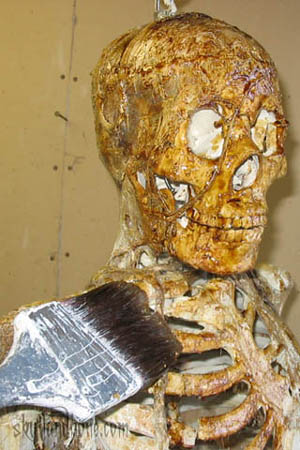
Note: I believe this process can be done with just stain. I happened to like the color of the shellac so I used it.
Make sure you have dark shellac and dark wood stain. The shellac with get very dark if you paint several layers of it. Dark skin is key for the peeled-away skin look. Paint your corpse liberally with the stain. Try to get all the nooks and crannies. I resorted to pouring stain right down the arms and head of the corpse. I ruined my shoes with stain splashing, but the effect on the corpse was marvelous.

After staining the corpse, take black spray paint and spray the inside of the chest cavity, the eye sockets, and mist around the joint of the corpse.
The point of the black spray paint is to break up the monotony of the color of the stain. It also helps the corpse read better when you look at it in low-light situations. Darkening the chest interior is key to making the ribs pop visually. Take your time with the spray paint. Stand back a few feet and loft it into the areas where you desire darker values. Don’t overdo the black paint. You should not see the paint as much as feel it.

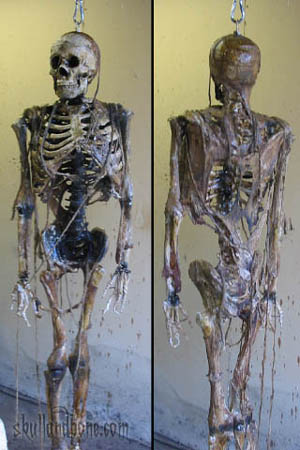
Go back with the brush and the shellac and paint the corpse again.
This step should do several things, it should help blend in the black spray paint. You should fill in any white holes or dry patches. I have been contemplating going back into the corpse with a small brush and some lighter brown/yellow to pop out the teeth a bit.

-Here is the famous Skull and Bone peeled-back skin technique-
So you decided that you wanted that peeled-back skin look! Go ahead and peel the skin away. I peeled some off the skull and some of the ribs. The white bones are a stark contrast to the painted and aged skin. Take stain and go over the areas of bone that are freshly exposed. This will help tie the bones into the color scheme. Don’t put too much shellac or stain on the fresh bones, they will darken quickly. The desired effect is to have a nice contrast between bone and rotted/dry skin.
Step 8. Hair!
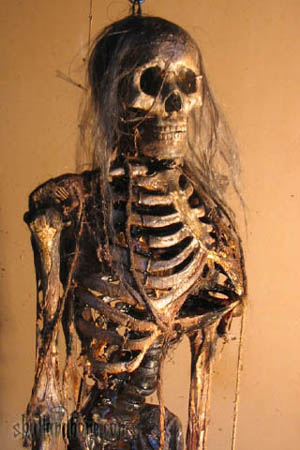
Hair is one of the easiest but often most overlooked stages of corpsing.
Get a cheap wig, and cut clumps of hair out of it. Grab the ends of the hair and dunk them into the latex. Press the hair onto the skull. I like a patchy long-haired look. I plan on experimenting with more hair and hairstyle on my next corpse. After placing all the hair, brush some stain or shellac over the lighter-colored latex that holds the hair in place.
Step 9. In hindsight.
-My first corpse had some really cool peeled-away skin. I wanted to have that look on my second corpse.
-I should have left more ‘skin’ to peel back. I cut too many holes in the skin on my second corpse. I also painted a bit too much latex on the bones directly. When I unified the surfaces of the skin and the bone with the latex adhesive, I also unified the way the stain looked across the whole surface. It was hard to see the difference between bone and skin after staining. I am not unhappy with the look. It is a different, more ‘dry’ look.
-It took me 3 hours to do the second corpse and 7 hours to do the first. Take your time, and enjoy finding out what you like for your own corpse.
-These materials did not seem to have adverse reactions when mixed. Your results may vary.
-I need to find a source for ears. I think the corpses need ears, and fingernails to be really creepy.
-I am going to knock a few teeth out of these guys too. The perfect smile does not cut it for me.
-I bet latex paint would work great with this method. I plan on trying some latex paint mixed with a tiny bit of carpet adhesive to see what happens.
– I want to add eyes, but not glossy clear eyes. I want to add some milky marbles that resemble something you might see in a cooked fish.
Step 10. Cleanup
Welp, I’ll admit I have not cleaned up yet. I did some experiments with cleaners and found that the best way to avoid a mess is to not make a mess. Consult the cans of the items in use for how to clean up properly. I’ll admit, as I write this tutorial I see that my fingers stick slightly to the keyboard. I might not be the one to ask =P….
Step 11. Send me a picture!
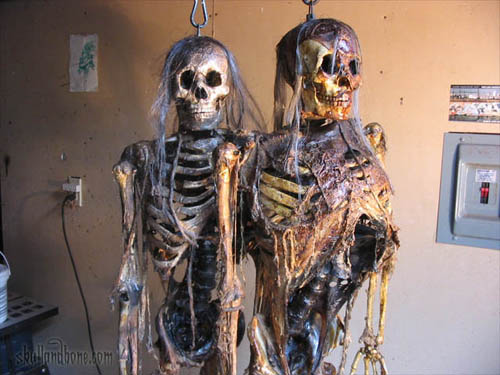
I would love to see some of the corpses that result from this tutorial! Please send pictures to the contact below and I will try to post them.
Gallery of Corpses

Krough’s Corpse
Check out Krough’s great corpsing. He used a little bit of latex paint to add color to his adhesive. This is going to be the body for a very wicked scarecrow.
Here is Krough’s completed scarecrow. I love the different textures. Especially the material on the face.
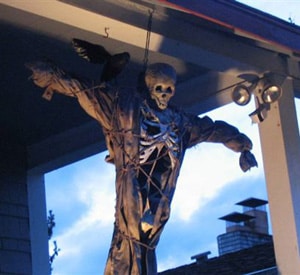
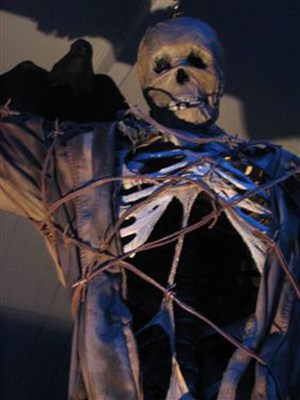
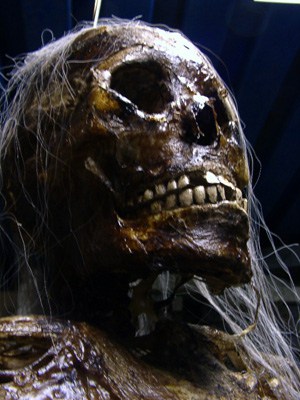
Blackwidow’s Corspse
Blackwidow from www.thewidowsden.com sent me pictures of her awesome corpsing job. Amazing attention to detail. The yellow teeth really creep me out….
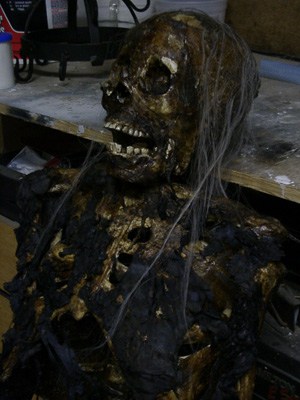
The layers of texture really make this a convincing corpse. As they say, the devil is in the details. This corpse is very well done!
FAQs
Q- Where can I find these materials?
A- I got all the materials at Home Depot, except the pantyhose and the buckies.
Q- One Question I do have. They sell some cheap skeletons at Big Lots, can I almost get the same effect as yours since you mentioned them on your site?
A- I have never used a blucky (the blow molded skeletons) with this method. I think this corpsing would work pretty good on a blucky. However, I don’t think it would work well on foam. Foam has a way of getting eaten up by my experiments.
